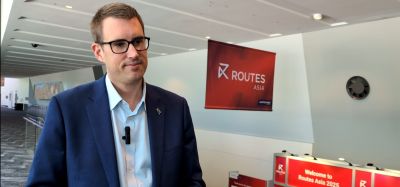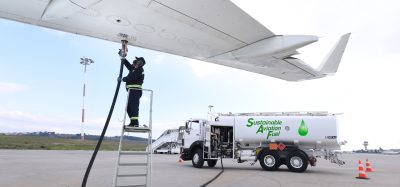The jet fuel infrastructure crisis
- Like
- Digg
- Del
- Tumblr
- VKontakte
- Buffer
- Love This
- Odnoklassniki
- Meneame
- Blogger
- Amazon
- Yahoo Mail
- Gmail
- AOL
- Newsvine
- HackerNews
- Evernote
- MySpace
- Mail.ru
- Viadeo
- Line
- Comments
- Yummly
- SMS
- Viber
- Telegram
- Subscribe
- Skype
- Facebook Messenger
- Kakao
- LiveJournal
- Yammer
- Edgar
- Fintel
- Mix
- Instapaper
- Copy Link
Posted: 10 June 2005 | Robert M Sturtz, Managing Director Strategic Sourcing- Fuel, United Airlines | 1 comment
In this article Bob Sturtz explores the factors that are leaving jet fuel delivery infrastructure lagging behind air travel growth.
In this article Bob Sturtz explores the factors that are leaving jet fuel delivery infrastructure lagging behind air travel growth.
As demand for air travel in the U.S. has increased during the last few decades and airports have made major capital investments to handle more passengers and aircraft, it has been taken for granted that aviation jet fuel would be available to meet the demand. For the past couple of years numerous factors impacting various segments of the jet fuel supply chain have raised cause for concern.
To understand what is happening, it is useful to understand how jet fuel is produced, transported and priced. Jet fuel is produced from crude oil and is termed a distillate product with characteristics similar to kerosene, home heating oil and diesel fuel. In general most refiners convert less than 10 per cent of their crude oil into jet fuel. The amount of jet fuel that a refiner can produce will vary based on the technological complexity of the refinery and the profitability of jet fuel compared to all the other products produced by the refinery.
There are three major concentrations of refineries in the U.S. – the U.S. Gulf Coast, New York Harbour (including Philadelphia) and the U.S. West Coast, primarily the Los Angeles area. From each of these areas jet fuel can be loaded aboard product ships for export or sent to large multi-product pipelines for distribution to many of the larger population centres in this country. It is these same pipelines that carry gasoline, diesel fuel and home heating oil, as well as other products.
Despite the fact that demand for petroleum products has continued to grow, no new refineries have been built in the United States for more than three decades and a number of inland refineries have closed. The only new capacity we have seen has come from upgrades to existing refineries and increases in the utilisation of these facilities. The historically high utilisation rates have led to an increasing number of refinery problems. Additionally we have seen the construction of only one new major common carrier product pipeline in the last 20 years. The lack of new refining capacity and the lack of sufficient pipeline capacity to transport jet fuel have led to an increasing level of imports and an increasing number of months each year in which many pipelines limit the amount of fuel each shipper can move.
Specification changes
Changes to the product specifications of gasoline and diesel have also had a significant impact on both the production and transportation of jet fuel. Changes to these products have not been uniform across the country and the unique specifications of the reformulated gasoline and diesel products make them difficult to purchase from foreign refineries. These products therefore yield higher margins to the refiners, with the consequence of prompting them to maximise the production of these products, often at the expense of jet fuel. As the jet fuel specification is similar throughout the world, jet fuel is easier to import and purchase in the international market. The various types of gasoline and diesel products require segregation during storage and transit to maintain product integrity. This has led to a shortage of jet fuel storage and an increase in the price of that storage, as well as increases in the number of jet fuel imports. Also as the need for jet fuel imports increases, the jet fuel increasingly has to be imported from further distances, often as far away as Korea or the Arabian Gulf. The longer supply chain subjects the jet fuel shipments to an increasing number of problems and lowers the overall reliability of the supply chain.
Contamination
Jet fuel is difficult to transport because it cannot tolerate even minute quantities of contaminants. Therefore pipelines cannot add even tiny quantities of drag reducer to jet fuel that permit the pipeline to increase the amount of jet fuel that can be shipped. This makes it a less attractive option to ship compared to other petroleum products. In addition to this, jet fuel is the only product that isn’t dyed by either the EPA (Environmental Protection Agency) or the IRS (Internal Revenue Service), for identification and taxation purposes because the colouring agent is a contaminant. Even small amounts of dye bleeding during the transportation or storage of jet fuel could render the batch of jet fuel unfit for aviation use. Compounding this problem is the fact that product specifications are due to change again in June 2006, requiring only five parts/million of sulphur to be present in gasoline and diesel. Since jet fuel is a high sulphur product, distribution companies are very concerned that it may be the jet fuel that will become a major source of contamination for the other products. Jet fuel also requires additional handling as it must be filtered to remove particulate and water that it picks up in transit through the pipelines.
The result of all these quality issues is that jet fuel is problematic for the pipelines and subsequently we have seen a rise in the number of contamination issues. For example last year O’Hare Airport was within six days of running short of fuel, as most of the shipments on the Texas Eastern Pipeline from the U.S. Gulf were held up until a source of contamination that was pushing the thermo-stability of the fuel off-spec could be found and dealt with.
Further compounding the supply chain problems is the oil industries’ interest in reducing working capital by reducing inventories. Many suppliers have gone to just-in-time fuel delivery practices, believing it is the consumer’s responsibility to protect his business. Many airlines purchase their fuel directly into their aircraft and assume their suppliers hold sufficient inventory on or close to the airport. In many instances this is not the case. As a result the airlines and airports are at risk and have little or no time to react to supply chain problems. The airline industry has experienced more fuel supply disruptions in the last two years than I have seen in more than 20 years in the business. This problem is not being addressed by the airlines, who are unwilling to pay for the additional inventory and supply integrity, or by the suppliers who argue that their margins do not permit them to carry inventory and still compete. To improve supply integrity, I believe that the Airport Authority needs to play a role in determining reasonable inventory requirements to minimise fuel problems, shortages, or even complete outages.
Case studies
A clear example of how the factors discussed have come together to cause a major problem is at Dulles International Airport (IAD) just outside of Washington, D.C. This airport, opened in 1960, had two major sources of fuel – the Plantation Pipeline and the Colonial Pipeline. Both these lines are multi-product lines that move product from U.S. Gulf Coast refineries up the Atlantic Coast. Both pipelines have breakout tankage about 15-25 miles from the airport and 6-inch pipelines to the airport. Due to environmental issues made more pronounced by a major leak about ten years ago, one of the three storage facilities in the area was taken out of service. As a result of growth in the gasoline market and the higher margins available in that market, the second facility took their tanks out of jet service and into gasoline service. This left only one small storage facility in jet service on the Colonial Pipeline, whose 6-inch pipeline could theoretically move 20,000 barrels/day but now due to storage constraints was limited to moving only 9,000 barrels/day to the airport.
As demand at IAD increased last fall, Plantation was forced to pro-rate its shipments on the 6-inch line from the breakout storage to the airport. As airport demand grew to over 33,000 barrels per day, the airlines were forced to truck fuel in to meet demand. Compounding this problem recently is the fact that both the Plantation Pipeline and Colonial Pipeline were either pro-rated or limiting product shipments from the Gulf, because high demand for petroleum products in general was causing them to be oversubscribed. The problem has been exacerbated as the Colonial Pipeline has had numerous fuel quality issues such as red dye contamination. This problem is not unique to IAD as we are seeing pipelines pro-rating their lines for increasing amounts each year.
A solution to this problem has been identified. It involves building a 4-mile pipeline from Colonial’s mainline to the airport and constructing an additional 300,000 barrels of jet storage on the airport. However, it is anticipated that the permitting process and the necessary due diligence alone will take 12-18 months for the four miles of pipe and the airport construction. In the meantime it is likely that jet fuel prices on the airport will increase significantly as demand at IAD outstrips availability. It is also likely that shortages will occur until the new pipeline can be built.
An interesting element of this problem was how the issue was perceived by the various parties. Based on growth projections provided by the airport, the problem was identified more than one year in advance. The solution at that time would have required the airlines to lease additional storage to provide Colonial access until the pipeline could be extended.
However, the airlines that jointly lease and operate the airport facility viewed this as their suppliers’ problem. The suppliers who perceive that jet fuel margins are too low to invest in infrastructure were content to see limited infrastructure lead to higher prices. They were also concerned that additional investments made by them would have to be passed on to their customers, which would make them non-competitive. The only party that was prepared to act was MWAA (The Metropolitan Washington Airport Authority), believing that despite their multi-billion dollar airport improvement program, they may have their growth limited by a lack of fuel. It was only through the MWAA’s intervention that progress was made and corrective actions taken.
An analysis of the Denver Airport indicates that there is a limit to the amount of jet fuel that can be physically produced and transported to Denver. The major common carrier pipeline is close to capacity and pro-rated for a portion of the year. The proprietary line coming in from West Texas has capacity but the amount of jet fuel the refinery can produce is limited. With Denver International’s growth projections, it is likely airport demand will outpace supply within three to four years. This will be considerably sooner if Denver is successful in attracting new international flying. A likely alternative to pipeline transport into this market is railcars out of the U.S. Gulf, an alternative that will significantly increase fuel costs at this airport and will take at least 18 months to two years to construct.
In Los Angeles, which is the largest airport in terms of fuel consumption in the world, the problem is slightly different, but largely the result of the refining problems discussed earlier. Twenty years ago LAX’s fuel consumption was met by five major oil companies with pipelines connected directly from their local refineries to the airport. In time, two of the refineries were closed. The LAXFUEL Corporation, which is owned by 55 airlines, leased 1.5 million barrels of off-airport storage. Through this storage, fuel can be imported from various sources throughout the world. As the remaining refiners take advantage of the higher margins available by producing CARB (California Air Resource Board) gasoline and diesel, an increasing amount of jet fuel is being imported. With continued growth at the airport the facilities are being totally utilised and at times requests for imports are being refused. This is manifesting itself as unmet demand and significantly higher prices. In this case a lack of storage and the problems of scheduling ships from half way around the world are creating a difficult supply situation. More than 50 per cent of the fuel demand at LAX now arrives by ship. This difficult situation is made worse by the oil industy’s just-in-time inventory process. In February of 2004 the Los Angeles airport came very close to completely running out of fuel.
Time for action
During the past year the airlines have experienced severe fuel problems at Sydney, Washington Dulles, Chicago, Oakland, San Juan, the Florida airports, Las Vegas, Baltimore and Washington National Airport. It is evident by the increasing number of problems that the jet fuel supply chain has become increasingly less reliable and actions need to be taken to compensate for the lack of reliability.
During the last two decades the U.S. airlines have done a good job of building and improving the on-airport infrastructure. In many cases new fuel storage and distribution facilities provided increased supply integrity by providing additional fuel storage on the airport. This has enabled the airlines to weather pipeline and refinery outages and fuel quality problems. However with the changes in the fuel business today the airlines and particularly the airport authorities must look beyond their own airport fuel facilities to determine whether their sources of supply are adequate.
It is necessary for the Airport Authorities to question and challenge the airlines or oil companies operating the airport fuel facilities, the suppliers that provide the fuel and the pipelines and transportation companies to ensure that the fuel and infrastructure is adequate to meet the future demands of the airport. The fact is there are no economic incentives for any of these parties to address these issues on their own. With good information and planning these problems can be addressed and overcome by airport management, but due to the time it takes to implement solutions, action needs to be taken well in advance of the problem.
Robert M Sturtz
Bob holds a degree in Engineering and an MBA. He has been with United airlines for 29 years, the last 22 of which have been in the Petroleum Administration Department. He is currently responsible for the purchase and distribution of three billion gallons of jet fuel, as well as the service contracts for fuelling United’s aircraft. He is also currently the President of the Honolulu Fuels Facility Corp., the IADFUELS Corp., the LAXFUEL Corp., the Denver Fuel Committee and the SFOFUELS Corp. He has served as Vice-Chairman and Chairman of the IATA Fuel Trade Group.


















Hello Bob
My name is Craig Watel and I am the General Manager of Midstream Logistics for ATMI (a Total SA affiliate in the U.S.).
I have been tasked with a small project to try to assist our Specialties division with understanding the logistics of supplying jet fuel (Colonial 54 grade) off Colonial, to the Philadelphia airport.
Would it be possible for us to correspond (talk or write) on this topic briefly as I note that you have done the research?
Please let me know sir.